![]()
![]()
![]()
Use LEFT and RIGHT arrow keys to navigate between flashcards;
Use UP and DOWN arrow keys to flip the card;
H to show hint;
A reads text to speech;
49 Cards in this Set
- Front
- Back
|
Why do humans only see shades of gray at night?
|
B/c rod cells (which only paint w/ grey) are specialized for low light detection (nighttime). and cone cells yield color vision in bright light (day time).
|
|
|
What is the net result of a photon hitting a rod cell?
|
Produces a paradoxical hyperpolarization of the rod cell.
|
|
|
What is the affect of hyperpolarization of rods and cones?
|
Hyperpolarization decreases the release of the NT glutamate to the bipolar cells and invokes an opposite excitatory response in bipolar cells of the "ON" pathway.
|
|
|
What does the Rod outer segment consist of?
|
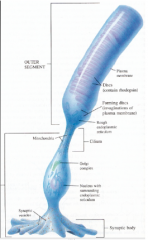
1000-2000 flattened disks containing rhodopsin that are surrounded by a membrane. These discs absorb light and transmit this information into amplified transmitter molecules that transduce the signal into electrical signals.
|
|
|
What does the Rod inner segment contain?
|
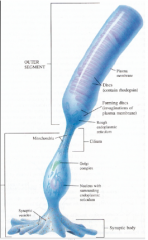
The cell nucleus w/ surrounding ER, Golgi apparatus and metabolic equipment (mitochondria) as well as a synaptic body that connects to neurons in the retina.
|
|
|
What is the primary light transduction step in Rods?
|
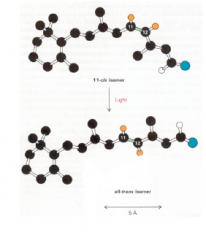
Conversion of 11-cis Retinal to all-trans-retinal (aka "Vitamin A aldehyde")
|
|
|
What is the primary chromophore of vertebrate and invertebrate retinae?
|
11-cis retinal
|
|
|
What is 11-cis-retinal formed from?
|
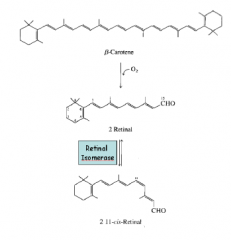
beta-carotene, which undergoes oxidative cleavage to produce the aldehydic form of vitamin A.
|
|
|
What does retinal isomerase do?
|
Catalyzes isomerization of 2-retinal to the cis form 11-cis-retinal.
|
|
|
What does vitamin A deficiency cause in mammals? in children?
|
night blindness and progressing in children to xerophthalmia (no tears) and total blindness.
|
|
|
What materials is Rhodopsin composed of?
|
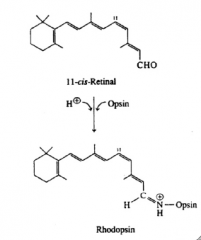
Opsin and 11-cis-retinal.
|
|
|
How is 11-cis retinal bound to opsin?
|
By a schiff base and sits w/ its long axis nearly parallel to the plane of the membrane.
|
|
|
How much light is absorbed by 11-cis retinal and opsin?
|
By themselves they absorb almost no light, but when they combine to form rhodopsin a broad spectrum from 350 to 620ish nm occurs. The peak is at 500nm.
|
|
|
What is the storage form of retinal?
|
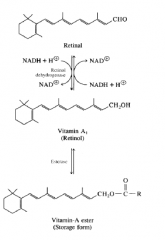
|
|
|
What organism contains a second set of retinal-based light-transducing proteins?
|
The archaebacteria Halobacterium Salinarium.
|
|
|
What is the the light-vision cascade pathway succinctly?
|

light stimulates rhodopsin to activate transducin to de-inhibit (activate) phosphophodiesterase to decrease cGMP levels to close sodium channels to hyperpolarize the cell
|
|
|
What deactivates rhodopsin?
|
Rhodopsin kinase and arrestin.
|
|
|
What is the very first step in vision?
|
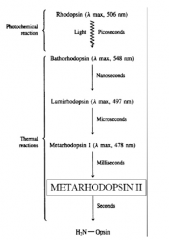
Conversion of light energy into atomic motion. Light excites 11-cis-retinal w/in 200 femtoseconds to increase the max absorption of rhodopsin which morphs rhodopsin into bathorhodopsin.
|
|
|
What do the thermal reactions cause in the cascade that occurs after formation of Bathorhodopsin?
|
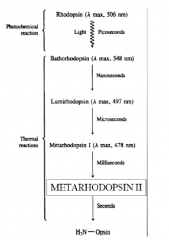
Cause formation of other transient species, eventually culminating in Metarhodopsin II, which is activated rhodopsin.
|
|
|
Why is their low dark noise in the eyes?
|
B/c the activation barrier (Ea) b/e rhodopsin and metarhodopsin is HUGE (40Kcal); so the pathway is only activated when you see something and does not cause artifacts.
|
|
|
What is transducin?
|
A guanine nucleotide-binding protein (G protein) containing three subunits (alpha, beta, gamma).
|
|
|
What does Metarhodopsin II, activated rhodopsin, interact with?
|
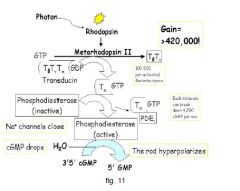
The alpha subunit of transducin, causing an exchange of GDP (which is bound to inactive transducin) for GTP.
|
|
|
What happens in the vision cascade once GTP is bound to transducin?
|
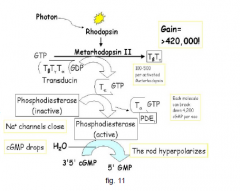
the beta and gamma subunits of transducin dissociate, which yields activated transducin (Talpha-GTP).
|
|
|
What does Talpha-GTP (activated transducin) do?
|

Binds to the inhibitory subunit (gamma subunit) of phosphodiesterase and removes it from the complex. which de-inhibits (activates) PDE.
|
|
|
What is phosphodiesterase?
|

An enzyme that catalyzes the hydrolysis of cGMP to 5'-GMP. It contains three subunits (alpha, beta and gamma) but the gamma subunit is inhibitory.
|
|
|
What is the amplification aspect of vision?
|
one single photon activates one rhodopsin. Which activates a 1000 Metarhodopsin which activate a 1000 TalphaGTP which activate a 1000 PDEs, etc. Each step activates a huge amount of the next steps enzymes which causes amplification.
|
|
|
What is the resting membrane potential of rod and cone cells?
|
Most neural membranes have a resting membrane potential of ~ -60mV, but rod and cone cells are leaky towards sodium so their membranes have a more positive resting membrane potential.
|
|
|
Why is vision so sensitive to anoxia?
*anoxia is loss of oxygen. |
B/c in order maintain a sodium gradient across their membranes (w/ more sodium outside, b/c remember their membranes are leaky to Na and Ca) the rods and cones must constantly use large numbers of Na/K ATPases. SO they use tons of ATP and run out quickly, so w/o oxgyen theres no ATP to maintain the gradients.
|
|
|
What keeps the Na channels in rods and cones open?
|
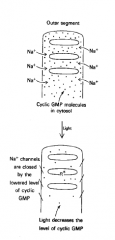
A high concentration of cGMP.
|
|
|
What does PDE do when it is in its activated PDEalpha,beta form?
|
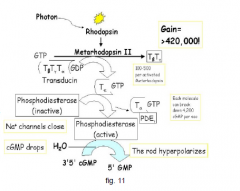
It causes hydrolysis of cGMP to GMP which causes NA channels to close. The resultant decrease in sodium ion influx causes the interior to become more negative, thus hyperpolarized.
|
|
|
What is the difference in Rod cell activation at low and high light levels?
|
light-adapted rods require way more photons to activate them, which is why moving from a lightly light room into a dark room makes you feel blind. Your rods require more photons to be activated than are entering the retina.
This is also why moving from a dark room into bright light is so blinding. Your rods are in superman mode and are being excited by every photon that is hitting them which causes this blast of bleached out light. |
|
|
How is hyperpolarization converted into a positive signal?
|
Hyperpolarized pulses from the rods/cones decrease the release of Glutamate to the bipolar cells which evokes an opposite, excitatory response in these cells.
|
|
|
How is the signal for vision turned off so you can refresh the picture?
|
Transducin has a built-in GTPase activity that hydrolyzes the GTP bound to the alpha subunit (so it turns itself off)
BUT rhodopsin has to be turned off or it will keep causing the cycle to turn. Rapid rhodopsin inactivation is accomplished by rhodopsin kinase and arrestin. (*note: rhodopsin degrades after ~1min. but you don't want your vision to be refreshed every MINUTE you need it refreshed a hundred times/second!) |
|
|
What does rhodopsin kinase do?
|
Phosphorylates rhodopsin at serine and threonine residues at the C-terminal.
|
|
|
What rapidly deactivates rhodopsin and fine-tunes the sensitivity to external light levels?
|
Rhodopsin kinase
|
|
|
What causes arrestin to bind to rhodopsin?
|
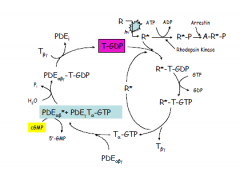
Phosphorylation of rhodopsin by rhodopsin kinase.
|
|
|
What does arrestin do?
|
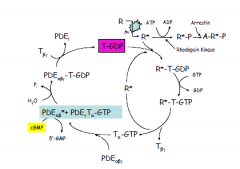
Associates w/ phosphorylated rhodopsin and blocks further binding of transducin, which blocks the signal.
|
|
|
What Sy would a pt who lacked the protein arrestin exhibit?
|
A prolonged photoresponse.
|
|
|
What does the protein recoverin do?
|
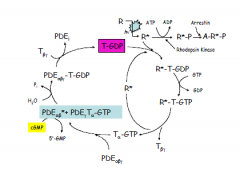
Inhibits rhodopsin kinase in low light.
|
|
|
What is the activation mechanism of recoverin?
|
![Recoverin is controlled by intracellular [Ca]. At low Ca levels recoverin dissociates and rhodopsin kinase is activated. At high Ca levels recoverin is activated.
Ca enters the cell through the Na leak channels only in dim light. SO at dim ligh...](https://images.cram.com/images/upload-flashcards/85/52/25/3855225_m.png)
Recoverin is controlled by intracellular [Ca]. At low Ca levels recoverin dissociates and rhodopsin kinase is activated. At high Ca levels recoverin is activated.
Ca enters the cell through the Na leak channels only in dim light. SO at dim light [Ca] inc. and activate recoverin which inhibits rhodopsin kinase. |
|
|
How does light control rhodopsin kinase activity?
|
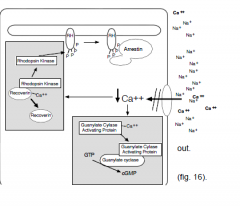
Light controls RK indirectly through its effects on Ca levels.
|
|
|
How are cGMP levels restored after a rod/cone is hyperpolarized?
|
![Through synthesis by guanylate cyclase which is facilitated by a decrease in [Ca]. Low Ca is sensed by guanylate cyclase activating protein, which binds GC and increases its activity at low Ca levels.](https://images.cram.com/images/upload-flashcards/85/52/19/3855219_m.png)
Through synthesis by guanylate cyclase which is facilitated by a decrease in [Ca]. Low Ca is sensed by guanylate cyclase activating protein, which binds GC and increases its activity at low Ca levels.
|
|
|
What Sys will a pt pw if they inherit a mutated rhodopsin gene that causes the protein to never be fully turned off?
|
It will cause a constant low level of signaling that is indistinguishable from a true light response. It will impair rod perception to dim but not to brighter light.
SO the pt will suffer from congenital stationary night blindness. They will see well in normal light but not at light thresholds above normal. Unfortunately this will eventually also lead to retinitis pigmentosa and blindness. |
|
|
What is the difference b/e rods and cones?
|
All rods/cones contain 11-cis-retinal but they differ in localized protein-retinal interactions. Which tweak the absorption spectra to yield different absorption maxima.
|
|
|
Why do cones not produce as strong a response to weak light as cones?
|
B/c the signals from cones are not summated over the entire retina.
|
|
|
What are the wavelengths that the rod/cone cells absorb light at?
|
Rods: ~500
Blue cone: 440 Green cone: 530 Red-Yellow cone: 570 |
|
|
What would a mutation to the specific absorbancy of a particular cone cause?
|
It would shift what color that cell perceives, so if a Red-cone had a mutation increasing its wavelength it would cause the cell to perceive a deeper red.
|
|
|
What is the genetic cause of color blindness? what is the most common color blindness?
|
Loss of red/green pigment
The red/green pigment genes are arranged in a head to tail tandem array on the X chromosome, so that makes them susceptible to homologous but unequal recombination. |
|
|
What would happen if PDE6 is inhibited in the retina?
|
After a light pulse, cGMP levels will not drop as low, fewer channels will be closed, Na and Ca ions will not be excluded and less hyperpolarization will occur, yielding a lower signal output.
|

